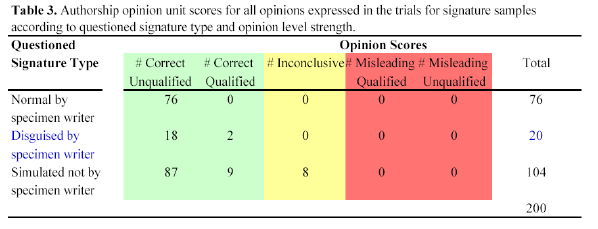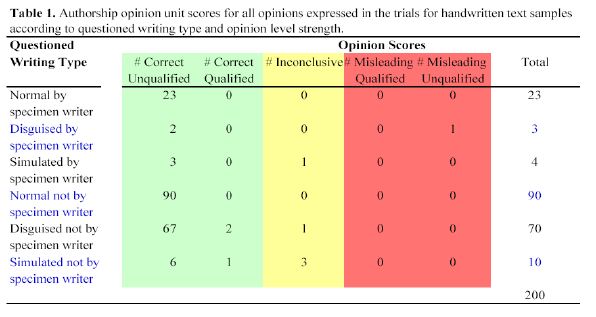For the prospective medical patient, legal client, auto mechanic customer, or anyone seeking to retain services, a big concern is "Can this person do the work?"
In a court of law an expert witness is allowed to give opinion evidence. The judge, jurors, attorneys and other participants want to know how likely it is that the opinion of an expert is accurate.
These are reasonable concerns. How does the document examiner show that he/she can do the work of handwriting examination and identification, and technical examination of documents? How does the document examiner answer the question, "What is your error rate?"
A well-developed program of proficiency testing gives the examiner a tool to use in answering these questions. Properly used, as a learning/growing experience, proficiency testing shows the examiner where improvement is needed and helps the examiner to expand his or her skills.
A test of proficiency in the skill of Handwriting Identification has been developed by the Forensic Expertise Profiling Laboratory (FEPL) at La Trobe University in Victoria, Australia under the leadership of Drs. Bryan Found and Doug Rogers. The FEPL testing program is a two-part test.
For the year 2004, in part one of the test 100 prepared questioned signatures had to be compared to a group of known signature specimens. In part two, given later in the year, questioned handwritten text had to be evaluated in comparison to known handwritten text. This would be similar to an anonymous note problem in casework. An additional test addressed questions of Line Sequence (which intersecting line was place above the other).
All known and questioned material is prepared by subjects drawn from graduate students, staff members of the university, and the general public. The writers might be instructed to write normally, to disguise their writing, to simulate the writing of other writers, and to simulate their own writings. Tests may vary in format and content. For example, in one test, one of the "forgers" contributing to the pool of non-genuine signatures was a caligrapher. In another test, there were no disguised signatures included amongst the questioned signatures.
Each test participant receives a package containing high quality printouts of the known and questioned material, as well as a CD containing pdf files of the material. For each questioned item the examiner (working alone or in a peer-review pair) reaches an authorship opinion and level of confidence ranging from 1-5 (3 being inconclusive) and a process opinion (the sample is naturally written, or the sample is a product of disguise or simulation).
Examiners world-wide participate in the program. Strict privacy is maintained, and participants know each other only by code number. For each of the two parts of the test there is a working time of 6-8 weeks, and a deadline for return of the answer sheet to FEPL. Participants receive detailed results containing all of the correct answers, and a breakdown by question and by category of all individual responses (by code number) and statistical information about individual and total responses. This information package, called a Revision and Corrective Action Package (RACAP), can be used by the examiner to analyze his or her own performance individually and in comparison to the group. Most importantly, each examiner can use this information to increase his/her skill level.
The first year of test participation is a baseline year. After the completion of the second year, the examiner can request a profiling certificate which details the number and percentage of correct, inconclusive and misleading answers given in various categories. Handwriting Identification is a complex skill with several subskills - identification of genuine writing, disguised writing, and simulated writing each require specific knowledge and ability. Each examiner may also reach an opinion of "inconclusive" in some, many or few of the 100 items on the test. The profiling certificate explains all of the categories of answers and the statistical analysis of the performance of the examiner. The certificate is a resource that the examiner can draw upon to illustrate his/her proficiency in signature and handwriting identification tasks.
Participating examiners can publish their code numbers or results and interested parties can verify the participant's results by contacting the FEPL directly.
BELOW ARE SOME SAMPLE TABLES OF INFORMATION FROM A RECENT RACAP


Comments from this test participant: If you are familiar with statistics, you realize that many different statistical images can be painted from the same data. Any conslusions drawn from this data would relate only to this cycle of testing and does not guarantee that the examiner will be correct in any particular situation.
Collaborative Testing Services (CTS) in Herndon, Virginia also offers annual or semi-annual proficiency testing in many fields, forensic and otherwise. The Questioned Document section of the American Academy of Forensic Sciences (AAFS) assists CTS in producing and administering two annual tests in Handwriting Examination and in Document Examination, which includes handwriting examination and the technical areas (office machines, ink, paper, etc.) that are relevant to the field. Each test consists of one problem, which may have multiple parts.
These tests are conducted by code number, so that anonymity is preserved. The results of all participants (by code number) are available to all participants, which allows the examiners to compare their results with those of others.
Copyright © 2001-2008 Emily J. Will All Rights Reserved.
